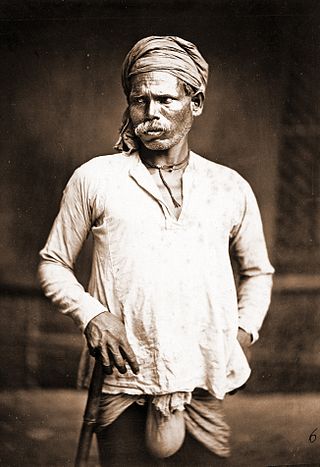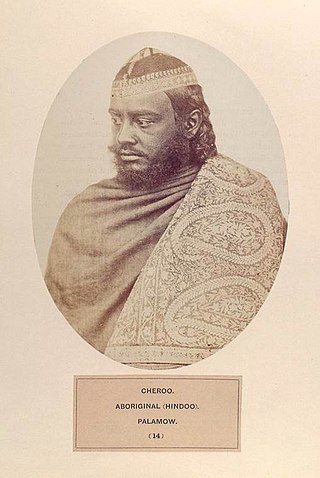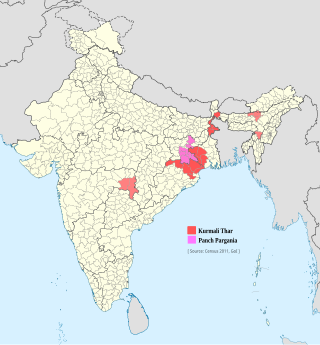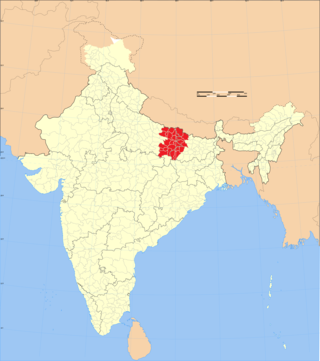Related Research Articles

Bhojpuri is an Indo-Aryan language native to the Bhojpur-Purvanchal region of India and the Terai region of Nepal. It is chiefly spoken in eastern Uttar Pradesh, western Bihar and western Jharkhand in India as well as western Madhesh and eastern Lumbini in Nepal. It is an eastern Indo Aryan language and as of 2000 it is spoken by about 5% of India's population. Bhojpuri is a descendant of Magadhi Prakrit and is related to Maithili, Magahi, Bangla, Odia, Assamese, and other eastern Indo-Aryan languages.

The Hindi Belt, also known as the Hindi Heartland, is a linguistic region encompassing parts of northern, central, eastern, and western India where various Northern, Central, Eastern and Western Indo-Aryan languages are spoken, which in a broader sense is termed as Hindi languages, with Standard Hindi serving as the lingua franca of the region.

The Dom, also known as Domra, Domba, Domaka, Dombara and Dombari, are castes, or groups, scattered across India. Dom were a caste of drummer. According to Tantra scriptures, the Dom were engaged in the occupations of singing and playing music. Historically, they were considered an untouchable caste called the Dalits and their traditional occupation was the disposal and cremation of dead bodies. They are in the list of Scheduled caste for Reservation in India in the Indian states of Uttar Pradesh, Bihar, Odisha, Andhra Pradesh, Jharkhand and West Bengal.
The Mahli are a community in the Indian states of Jharkhand, Odisha and West Bengal. Basketry is their main occupation. They speak the Mahali language, which belongs to the Munda group, and many of them also know Odia, Santali, Bengali, and Hindi. They are included in list of Scheduled Tribe.

The Baiga are an ethnic group found in central India primarily in the state of Madhya Pradesh, and in smaller numbers in the surrounding states of Uttar Pradesh, Chhattisgarh and Jharkhand. The largest number of Baiga is found in Baiga-chuk in Mandla district and Balaghat district of Madhya Pradesh. They have sub-castes: Bijhwar, Narotia, Bharotiya, Nahar, Rai maina and Kath maina. The name Baiga means "sorcerer-medicine man".

Chamar is a Dalit community classified as a Scheduled Caste under modern India's system of affirmative action. They are found throughout the Indian subcontinent, mainly in the northern states of India and in Pakistan and Nepal.

Lohar is considered to be a caste among Hindus and a clan among Muslims and Sikhs in the Indian states of Uttar Pradesh and Jharkhand, and in Nepal. They form traditionally artisanal castes. Writers of the Raj period often used the term Lohar as a synonym for blacksmith, although there are other traditional smiting communities, such as the Ramgarhia and Sikligar, and numerous non-traditional communities, including the Kayastha, Rajput and Brahmin.

Sansi are a formerly nomadic people from India that were classified as a criminal tribe in the 19th century by the British during the Raj period. They were stealing food supply from British Government. That's why the British government declared them thief.

Saraks is a community in Jharkhand, Bihar, Bengal, and Orissa. They have been followers of Jainism, such as vegetarianism, since ancient times, however, were isolated and separated from the main body of the Jain community in western, northern, and southern India and have been Jain Bengalis ever since. The governments of India and West Bengal both have classified some of the Saraks under Other Backward Classes since 1994 but many of them have been in the General category from the beginning itself.
The demographics of Uttar Pradesh is a complex topic, which is undergoing dynamic change. Uttar Pradesh is India's most populous state, and the largest subdivision in the world. It has a population of about 199,812,341 as per the 2011 census. If it were a separate country, Uttar Pradesh would be the world's fifth most populous nation, next only to China, the rest of India, the United States of America and Indonesia. Uttar Pradesh has a population more than that of Pakistan. There is an average population density of 828 persons per km2 i.e. 2,146 per sq mi. The capital of Uttar Pradesh is Lucknow, and Prayagraj serves as the state’s judicial capital. Hindus and Muslims both consider the state as a holy place.

The Tharu or Tharuhat languages are any of the Indo-Aryan languages spoken by the Tharu people of the Terai region in Nepal, and neighboring regions of Uttarakhand, Uttar Pradesh and Bihar in India.
The Dhanuk is an ethnic group found in India. In Bihar where they are significantly present, they have been categorised as the "lower backwards", along with several other castes constituting 32% of the state's population. In recent times they have been identifying themselves with the Kurmi caste along with the Mahto of Chhotanagpur. In Bihar, they are considered as a sub-caste of the Mandal caste and are often found using Mandal surname. In recent times, there has been attempt to forge a socio-political alliance between them and the twin castes of Koeri and the Kurmi, as a part of Luv-Kush equation.

Bhumij is a Munda ethnic group of India. They primarily live in the Indian states of West Bengal, Odisha, Assam and Jharkhand, mostly in the old Singhbhum district. Also in states like Bihar and Assam. There is also a sizeable population found in Bangladesh. Bhumijas speak the Bhumij language, an Austroasiatic language, and use Ol Onal script for writing.

The Chero is a caste found in the states of Bihar, Jharkhand and Uttar Pradesh in India.

Kurmali or Kudmali is an Indo-Aryan language classified as belonging to the Bihari group of languages spoken in eastern India. As a trade dialect, it is also known as Panchpargania, for the "five parganas" of the region it covers in Jharkhand. Kurmali language is spoken by around 550,000 people mainly in fringe regions of Jharkhand, Odisha and West Bengal, also a sizeable population speak Kurmali in Assam tea valleys. Kurmali is one of the demanded languages for enlisting in Eighth Schedule to the Constitution of India.

Bhojpur is a ethnolinguistic and cultural area in the Indian subcontinent where the Bhojpuri language is spoken as a mother tongue. The Bhojpuri region encompasses parts of the Indian states of Bihar, Uttar Pradesh, and Jharkhand, and the Madhesh, Gandaki and Lumbini provinces of Nepal.
Kharwar is a community found in the Indian states of Uttar Pradesh, Bihar, Jharkhand, Chhattisgarh, Orissa and West Bengal.

The Bhuiyan or Bhuiya are an indigenous community found in the Indian states of Bihar, Jharkhand, Madhya Pradesh, Odisha, Uttar Pradesh and West Bengal. They are not only geographically disparate but also have many cultural variations and subgroups.
Kori/koli is an Indian caste, who were traditionally weavers and fishermen. They are descendants of Ishvakuwanshi Raja Mandhata ji and Saint Kabir Das Ji Maharaj. Other names for this caste include Kamal, Kamalvansi and Shankhawar, Kabirpanthi and Julaha
Savarna or Savarni/Shavarna is a Brahmin gotra that comprises Kanyakubja Brahmins and Saryupareen Brahmins who are the descendants of sage Savarna Muni. The origins of Savarna gotra can be traced back to the origins of Kanyakubja Brahmins in Kannauj, Uttar Pradesh.
References
- 1 2 "Bedia".
{{cite journal}}: Cite journal requires|journal=(help) - ↑ "A-10 Individual Scheduled Caste Primary Census Abstract Data and its Appendix - Uttar Pradesh". Registrar General & Census Commissioner, India. Retrieved 4 February 2017.
- 1 2 3 Saswatik Tripathy, Aditi Khan (2018). "A Study on the Bedia Community of the Village Nagrabera, Jharkhand": 1. Retrieved 29 October 2022.
{{cite journal}}: Cite journal requires|journal=(help)